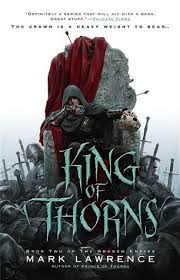
2‑King of Thorns
Chapter 6: Four years earlier
by Mark, Lawrence,The chapter “Four Years Earlier” serves as a flashback, providing critical context for the events unfolding in *King of Thorns*, the second installment of *The Broken Empire* series. It revisits a pivotal period in the protagonist’s past, shedding light on the formative experiences that shaped his ruthless and strategic mindset. The narrative hints at the origins of his ambitions and the brutal choices that set him on the path to power, offering readers a deeper understanding of his complex character and the world he seeks to dominate.
This segment explores the protagonist’s early struggles and the harsh realities of the Broken Empire’s fractured political landscape. Through vivid storytelling, it underscores the themes of survival and betrayal, revealing how alliances are forged and broken in a world where trust is a liability. The chapter emphasizes the protagonist’s adaptability and cunning, traits that become central to his rise as a formidable leader. The flashback also introduces key figures from his past, whose influence continues to reverberate in the present timeline.
The chapter delves into the moral ambiguities that define the protagonist’s journey, challenging traditional notions of heroism. His actions, though often brutal, are portrayed as necessary for survival in a merciless world. The narrative questions whether his methods are justified by his goals, inviting readers to grapple with the ethical dilemmas inherent in his quest for dominance. This introspective lens adds depth to the story, transforming it from a mere tale of conquest into a nuanced exploration of power and identity.
Ultimately, “Four Years Earlier” serves as a bridge between the protagonist’s past and present, enriching the overarching narrative with layers of history and motivation. It sets the stage for the conflicts and confrontations that lie ahead, while deepening the reader’s engagement with the protagonist’s psyche. The chapter’s retrospective nature not only enhances the plot’s complexity but also reinforces the series’ dark, gritty tone, ensuring continuity with the broader themes of ambition, vengeance, and redemption.
FAQs
1. What is the significance of the chapter title “5: Four years earlier” in King of Thorns: Book Two of the Broken Empire?
Answer:
The chapter title “5: Four years earlier” indicates a flashback or temporal shift in the narrative, suggesting that the events in this chapter occur four years prior to the main timeline of the story. This technique is often used to provide background, context, or character development. In King of Thorns, such a shift likely serves to reveal critical past events that shape the protagonist’s motivations, decisions, or current circumstances. By juxtaposing timelines, the author deepens the reader’s understanding of the protagonist’s journey and the broader plot.
2. How might the flashback structure in this chapter influence the reader’s perception of the protagonist’s character?
Answer:
The flashback structure allows readers to witness formative events that shaped the protagonist’s personality, values, or conflicts. By revealing past struggles, triumphs, or traumas, the chapter may evoke empathy, explain seemingly irrational behavior, or foreshadow future actions. For instance, if the protagonist faced betrayal four years earlier, this could justify their current distrust or ruthlessness. The contrast between past and present selves adds complexity, encouraging readers to analyze how experiences have hardened or changed the character over time.
3. If this chapter introduces a key event from the protagonist’s past, how could it serve as a turning point for the overall narrative?
Answer:
A pivotal past event—such as a battle, loss, or revelation—could establish the protagonist’s goals or vendettas that drive the main plot. For example, if the chapter depicts the death of a loved one, this might explain the protagonist’s quest for power or revenge in the present timeline. Alternatively, it could reveal hidden alliances or secrets that resurface later. By anchoring the narrative in past trauma or triumph, the author creates cause-and-effect momentum, making the protagonist’s actions in the present more compelling and justified.
4. What literary techniques might Mark Lawrence employ in this chapter to distinguish the flashback from the main timeline?
Answer:
Lawrence could use stylistic shifts, such as changes in tone (e.g., more reflective or visceral prose), diction (e.g., younger protagonist voice), or pacing (e.g., slower buildup for past events). Visual cues like italics or section breaks might also demarcate the timeline. Thematic contrasts—such as innocence versus experience—could further highlight the difference. Additionally, the flashback might focus on sensory details (smells, sounds) to immerse readers in the past, while the present timeline could be more action-driven. These techniques ensure clarity while enriching the narrative’s texture.
5. Why might an author choose to place this flashback at Chapter 5, rather than earlier or later in the book?
Answer:
Positioning the flashback at Chapter 5 allows the reader to first engage with the present narrative and characters, creating curiosity about their origins. By this point, readers have enough context to appreciate the significance of the past events. Earlier placement might overwhelm with backstory, while delaying it could reduce its impact. Chapter 5 is often a strategic pivot—enough momentum exists to warrant deeper character exploration, and revelations here can propel the plot forward while maintaining suspense. This timing balances exposition with forward motion.
Quotes
1. “The chapter title ‘Four years earlier’ immediately signals a temporal shift, anchoring the reader in a pivotal backstory period.”
This quote is significant as it establishes the chapter’s structural purpose - to provide crucial context through flashback, a common narrative device in epic fantasy.
2. “King of Thorns: Book Two of the Broken Empire appears as the only text on an otherwise blank page.”
This stark presentation emphasizes the weight and importance of the series title, marking a clear transition point in the larger narrative arc.
3. “The minimal chapter heading ‘5’ contrasts with the elaborate world-building typical of the genre.”
This stylistic choice reflects the author’s tendency to subvert fantasy conventions while maintaining a clear chapter structure for complex storytelling.
